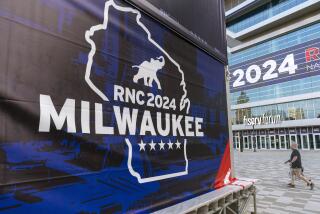The GOP takes its tea
The “tea party” movement is rapidly becoming just another faction of the national Republican Party.
Originally a grass-roots expression of anger at both parties, tea party groups eyed Democrats and Republicans with suspicion. And the parties were skeptical of the tea party too.
But in recent months, the GOP’s natural election-year appetite for voters, campaign volunteers and donors has caused the Republicans to take a more welcoming approach, and the tea partyers have responded.
Last week, Rep. Michele Bachmann (R-Minn.), the Sarah Palin of the House, formed an official Tea Party Caucus on Capitol Hill. Within three days, 42 members of Congress had signed up, all conservative Republicans.
The group won an almost-instant blessing from House Republican leader John A. Boehner (R-Ohio), who described his own experiences at tea party rallies with near-religious enthusiasm.
“Last Labor Day weekend, there were 18,000 people about a mile from my home — 18,000 people!” Boehner told reporters over lunch last week.
“These folks are the tip of an iceberg,” Boehner went on. “We should listen to them, we should work with them and we should walk amongst them.”
In a midterm election year, when turnout is hard to drum up, it’s easy to see why Republicans are eager to harness the tea party zeal. Just 18 months ago, the GOP was flat on its back. In some polls, fewer than 25% of voters admitted to being Republicans.
For the GOP, the tea party isn’t just a potential source of new voters and campaign volunteers; it’s a vehicle for rebranding and redemption. Before the tea party, the GOP was a tired old political organization, financed largely by business lobbyists, that voted repeatedly for deficit spending. Now, to hear Boehner and his lieutenants describe it, the Republican Party is the fully reformed instrument of a virtuous grass-roots anti-deficit movement.
That transformation has required something of a Faustian bargain. In Nevada and Kentucky, tea party activists helped hard-right conservatives in Republican Senate primaries defeat candidates the party’s establishment considered more likely to win in November’s general election. But that unhappiness is forgotten now, at least officially.
At this point, the tea party agenda (to the extent the amorphous coalition has one) and the official Republican Party agenda have largely merged.
Tea party activists say they’re angry about federal spending, the deficit, the growth of federal government power and President Obama’s healthcare plan. Republican leaders, as they outline their pitch for November’s election, say pretty much the same things.
For Republicans who want to broaden their party’s appeal, the good news is that tea party activists are concerned mostly about fiscal issues, not the social and religious issues that drove some independents away from the GOP in earlier days.
The bad news is that they rank unemployment well below the deficit on their list of concerns — the opposite of most voters. Tea party candidates Sharron Angle in Nevada and Rand Paul in Kentucky have both derided the unemployed as victims of their own laziness, a position that doesn’t play well beyond the Ayn Rand right.
And, of course, the tea party, like any grass-roots movement, includes its share of racists, xenophobes and extremists, which is one reason Bachmann’s Tea Party Caucus attracted only 40 of the 115 members of the House’s existing conservative caucus, the Republican Study Committee. Others, speaking privately, said they’d rather do without the headache of wondering what some tea party activist would do next. (Among California’s 19 Republicans, only two, Tom McClintock of Granite Bay and Gary Miller of Diamond Bar, signed up.)
On the tea party side, the movement is still divided among those who want to jump whole-hog into Republican politics and those who want to steer clear of traditional party allegiance. But the trend appears to be moving in favor of the GOP.
“You need to be part of a party to get candidates elected,” said Mark A. Skoda, a tea party activist from Memphis, Tenn., who helped found the National Tea Party Federation. “Standing out there with signs doesn’t get anything done.
“I know I’ll get some hate mail for that,” he added. “There are people in the movement who disagree with me. Make sure you say I’m not a spokesman for the tea party — because there is no spokesman for the tea party.”
He praised Bachmann and other GOP leaders for seeking tea party support.
“We’re not antagonistic toward the Republican Party,” he said. “We want to hold the Republican Party accountable. We want to be a change agent for the Republican Party.”
That’s already happened — in both directions. Both parties, tea and Republican, have already changed each other.
The tea party, by showing up at rallies and polling places, has strengthened those in the GOP who want to energize the conservative base with a campaign that focuses on cutting the deficit and repealing Obama’s healthcare law. The Republican leadership, by embracing the tea party and its message, has brought a movement that was once proudly nonpartisan ever deeper inside the conventional-politics tent.
Which is more likely to absorb the other? That’s easy. One of these groups isn’t really an organization; it has two years of experience, no national structure and no real fundraising operation. The other has operated since 1854, has built a formidable national organization and has survived electoral disaster more than once.
The history of American politics is littered with grass-roots movements that challenged existing parties, only to be co-opted and absorbed by them. The only thing new about the tea party is that it arose in an age when communications and politics move at lightning speed. Yes, it’s streaking across the Republican sky like a comet, but look fast; it may not be there long.
More to Read
Get the L.A. Times Politics newsletter
Deeply reported insights into legislation, politics and policy from Sacramento, Washington and beyond. In your inbox three times per week.
You may occasionally receive promotional content from the Los Angeles Times.











